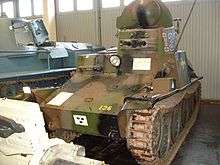Stridsvagn m/37
Stridsvagn m/37 (Strv m/37) was a Swedish-built version of the Czechoslovak ČKD AH-IV tankette.
| Stridsvagn m/37 | |
|---|---|
Stridsvagn m/37 | |
| Type | Tankette |
| Place of origin | Czechoslovakia |
| Service history | |
| In service | 1938-1953 |
| Used by | Sweden |
| Production history | |
| Designer | ČKD |
| Manufacturer | ČKD Jungner |
| Produced | 1938-1939 |
| No. built | 48 |
| Specifications | |
| Mass | 4.5 t (5.0 short tons; 4.4 long tons) [1] |
| Length | 3.4 m (11 ft 2 in) [1] |
| Width | 1.85 m (6 ft 1 in) [1] |
| Height | 1.95 m (6 ft 5 in) [1] |
| Crew | 2 [1] |
| Armor | 6–15 mm (0.24–0.59 in) [1] |
Main armament | 2× 8 mm m/36 machine guns [1] with 3960 rounds |
| Engine | Volvo FC-CKD 4.39 litre 6-cylinder OHV petrol engine [1] 85 hp [1] |
| Power/weight | 18.9 hp/tonne |
| Transmission | 5 speed Praga-Wilson preselected gearbox [1] |
Operational range | 200 km (120 mi) |
| Maximum speed | 60 km/h (37 mph) [1] |
History
The AH-IV was popular with Romania and Iran, and after a successful demonstration to Swedish authorities, during winter conditions in the Krkonoše Mountains, Sweden ordered 48 AH-IV-Sv in 1937. Two of these were built in Czechoslovakia; the other 46 were built as the Strv m/37 under license by Jungner in Oskarshamn, with AB Volvo providing a more powerful engine, transmission, and tracks, the armor was made by Avesta. The ČKD supplied most of the other components after building one prototype. The tankette was strongly modified, including the suppression of original driver's machine gun, this variant was heavier and larger, than the AH-IV. On the turret, was placed two Swedish-made machine guns, the 8 mm Ksp m/36 strv and a commander cupola. Inside the vehicle was room for a radio and the ammunition. In November 1938, the final components were shipped.[1][2][3]
Production
A total of 48 of these vehicles were delivered to the Swedish army between 1938 and 1939.[1]
Service
The Strv m/37s were first issued to the 1st Armored Battalion. Between 1943—44, were transferred to the newly formed armored brigades. Subsequently, the tankettes were in service with the infantry regiments I 2, I 9, I 10 and P 1 G Armored Company on Gotland.[4] The Strv m/37s lasted in service on Gotland until 1953, when they were withdrawn from service.[1][3]
Survivors
Eight of these tanks survive to this day, four in running order, of which one is in the Regimental Museum Strangnas, Sweden.[1]

Notes
- "Sweden". Tanks!. Retrieved 2012-05-19.
- Kliment and Francev, p. 115, 282
- "Strv m/37". Archived from the original on 2010-08-12. Retrieved 2009-05-17.
- Tarnstrom, p. 322
References
- Chamberlain, Peter; Ellis, Chris (2002) [1972]. Tanks of the World 1915-1945. p. 159.
- Kliment, Charles K.; Francev, Vladimír (1997). Czechoslovak Armored Fighting Vehicles. Atglen, PA: Schiffer. ISBN 0-7643-0141-1.
- Tarnstrom, Ronald (1996). The Sword of Scandinavia. (Armed Forces Handbooks). Lindsborg, KS: Trogen Books. ISBN 0-922037-13-2.